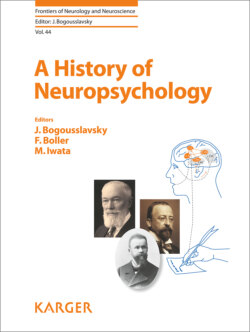Читать книгу A History of Neuropsychology - Группа авторов - Страница 68
На сайте Литреса книга снята с продажи.
Introduction
ОглавлениеAphasia is an acquired disorder of language defined principally by deficits in speech and speech understanding. Reading and writing are the visual counterparts of spoken language. Disorders of reading and writing, viz., alexia and agraphia, are often considered in relation to the language impairments of aphasia. Studies of aphasia, alexia, and agraphia play a historically important role in understanding the relation between brain function and complex behaviors.
1861 is a useful starting point for the history of alexia and agraphia. This is the year in which the French surgeon and anatomist Paul Broca (1824–1880) described his first case of aphemia (Broca’s aphasia) [1]. A convenient place to conclude is 1965, when Boston neurologist Norman Geschwind (1926–1984) ushered in the modern era of brain-behavior studies with his publication on cerebral disconnection syndromes [2]. Aspects of this topic have been reviewed [3, 4].
Broca proposed an anatomical center within the cerebral cortex that mediated articulate language. This model, expanded by others to accommodate reading and writing, came to include several cortical centers with discrete functional roles, interconnected by subcortical white matter pathways. As in Broca’s original case, the role of a center was inferred from symptoms after tissue destruction within a delimited cortical area. The role of a pathway was often inferred from the function of centers that it connected. Early proponents of the center–pathway model included Wernicke, Bastian, Charcot, and particularly Dejerine, who provided a key theoretical framework for alexia with and without agraphia. Opposing views were espoused by Hughlings Jackson and later by Marie, Head, and Goldstein. Geschwind’s work represented a rediscovery and elaboration of earlier models in the mode of Broca and his successors.
